Sabre Mk. 6, JG 71 Richtofen
I just ran across this model, which I built 12 years ago. I've rephotographed it for this article.
When the North American Sabre flew in 1947, it attracted attention throughout the West's aviation industry. In 1948, the Royal Canadian Air Force began serious planning for modernizing the equipment of their fighter squadrons. It was obvious that the best fighter available was the Sabre, and during that year the Canadian government made a decision to equip the RCAF with the Sabre. A license agreement was quickly reached with North American and Canadair became the manufacturer of the Canadian Sabre, known as the CL-13. A total of 1,815 CL-13 Sabres were built by Canadair between 1950-58.
The initial production batch was for ten, to verify the tools, which led to the production of the one and only Sabre Mk. I, a direct copy of the F-86A. By this time, North American was producing the improved F-86E with the all-flying tail that made the Sabre easily transonic in a dive. The outbreak of the Korean War changed the initial production contract from ten to 100. In 1951, the need of the USAF for the Sabre was so great that Canadair produced 100 F-86Es as the F-86E(M), which were sent to Korea to make up combat attrition.
The Sabre Mk. 2 introduced powered controls and the all-flying tail, while the only Sabre Mk. 3 was the first Canadian Sabre to use the magnificent Orenda 3 turbojet with 6,000 lb thrust, which was a vast improvement on the J-47GE-13 used for the Mk. 2 and on USAF Sabres. The Sabre Mk. 4 retained the GE engine and was produced for the RAF as that service's first swept-wing fighter. The Sabre Mk. 5 used the Orenda 10 with 6,500 lbs thrust.
The best Sabre ever produced by anyone was the Sabre Mk.6, which was to the rest of the Sabres as the MiG-17 was to the MiG-15 in terms of performance. Powered by the Orenda 14 with 7,275 lbs of thrust - a 150% increase over the power of US Sabres - the Sabre Mk. 6 outperformed every fighter in its class. It had the best climb performance and altitude of any Sabre; had the Sabre Mk.6 been the opponent of the MiG-15 over the Yalu in Korea, it would have been the Soviets who would have been looking up at 50,000 feet to find Sabres diving on them.
The first 220 Mk.6 Sabres had the 6-3 wing of the later F-86F series. The 6-3 wing planform was kept while slats were brought back from that point for the rest of the 655 Mk. 6s produced; this improved low-speed performance without losing high speed performance.
The first Sabre Mk.6 was completed November 2, 1954. 390 Mk 6s equipped the four RCAF Sabre wings serving in France and West Germany with NATO, where the Sabre Mk. 6 was considered the best dogfighter of any fighter serving with a NATO Air Force. 225 Sabre Mk.6s were supplied to the new German Luftwaffe, beginning in 1955, where they served until replaced by the F-104G in 1964.
Among the BundesLuftwaffe units that flew the Sabre Mk.6 was JG 71 Richtofen, the first fighter unit of the reconstituted air force, which was led by the world's leading fighter ace, Colonel Erich Hartmann, recently released from ten years as a Soviet Prisoner of War. To encourage morale in the unit, Hartmann introduced the famous black tulip-petal markings he had carried on his Bf-109 during the Second World War, making for a very striking and distinctive look for all of JG 71's Sabres.
The Sabre Mk. 6 lived up to its potential in the Indo-Pakistani War of 1971, where the 90 Sabre Mk. 6s sold by Germany to Iran and passed on to Pakistan were the main day fighter of the Pakistani Air Force, where they killed Hunters and Gnats and gave MiG-21s fits until overwhelmed by numbers.
THE KIT
The Hasegawa Sabre has appeared in many forms in the 15 years since it was first released. This particular kit was released by Revell-Germany as a Luftwaffe Sabre Mk.6, though it is really the F-86F-30 Sabre originally released by Hasegawa in 1994. Out of the box, the kit can be made as one of the 220 early-production Sabre Mk.6 aircraft with the 6-3 “hard” wing, of which only 30 or so were supplied to the BundesLuftwaffe, where they flew with the Sabre conversion unit, and even at that it still needs modification to be a real Sabre Mk.6. As anyone who has looked at photos of the Sabres of JG 71 knows, they were all later-production aircraft with the slatted wing.
Fortunately, Bill Scobie of Scobie-do Productions produced a very nice “drop-fit” all-resin slatted 6-3 wing, which can be used to create one of those Sabres. This is no longer available, but Red Roo picked up the early slatted wing for the F-86A/E, and produces a limited number of them twice a year. They are well worth picking up.
The kit provides markings for three different Luftwaffe Sabres - two in camouflage including one from 2.JG 71, and a natural metal Sabre from the Sabre conversion unit. An additional problem with these kit decals is that the tulip petals for the nose are the wrong shape and size, and are positioned inaccurately, which leads to inaccurate positioning of the serial codes on the forward fuselage, with the result that the model will look wrong. Fortunately, Air Doc released a sheet of decals for the Sabre Mk.6, which includes decals to do an airplane from either 1 or 2.JG 71. These have nose tulips that are the correct size and are positioned correctly, leading to correct positioning of the squadron codes.
CONSTRUCTION
Construction was straightforward, other than to modify the fuselage to be representative of the Sabre Mk.6. This included deleting the intake on the lower rear right fuselage and filling that in and smoothing it, and creating “sugar scoops” for the lower fuselage engine cooling intakes. I created these from sheet styrene, but there are resin aftermarket sets for this. By the early 1960s, which is the time period for the aircraft represented in these decals, the Sabre Mk.6 had exchanged its North American ejection seat for a Martin-Baker Mk.5 seat. I replaced the kit seat with a resin seat from an old Cutting Edge set.
The wing presented less difficulty in attaching to the fuselage, since it did not involve modification to the fuselage. Some putty, some sanding, some Tamiya “Mr. Surfacer” replacement was all it took. I left the slats off until after painting.
COLORS & MARKINGS
Painting:
The red leading edge of the fin and nose cone were painted with Tamiya Flat Red and masked off before painting the rest of the model. I mixed up a “slate blue grey” color that looked close to a color photo of Luftwaffe Sabres in one of my books. I used RLM71 dark green for the other upper surface color. The lower surface “silver-grey” color was mixed with Tamiya Flat Aluminum, Sky Grey and Flat White. When finished, the model was given an overall coat of Future.
Decals:
I used the Air Doc decals for the unit markings, and the kit decals for the national markings and stenciling. Everything went down without problem. When all was dry, I washed the model to get rid of decal solvent residue and gave the model an overall coat of Xtracrylix Satin Varnish.
FINAL CONSTRUCTION
I unmasked the canopy and windscreen and mounted the canopy in the open position. The slats were attached, as well as the dive brakes and landing gear. These aircraft were kept in excellent condition, so I did not do any weathering.
For those interested in doing a Sabre 6 now, if you get the Hasegawa F-86F-40 kit, you can cut off the wingtips and reduce the wingspan back to that of the Sabre 6, There is a resin conversion set for the slats - which have to be cut out of the kit wing - from Precision Resin Accessories (K48077) that will work very nicely. I have the set for another Mk 6 I am planning to do this year.
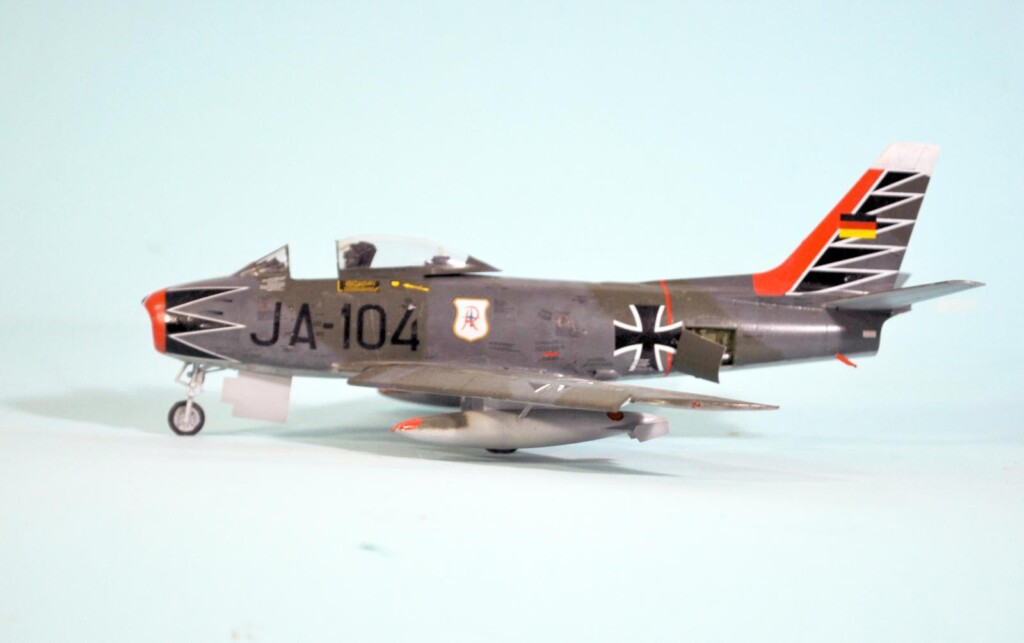
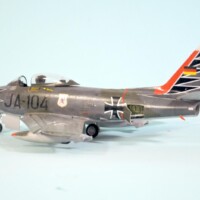

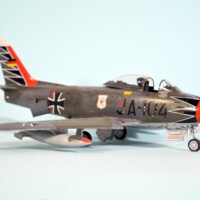
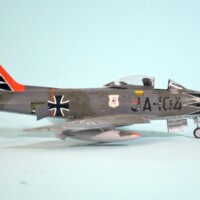

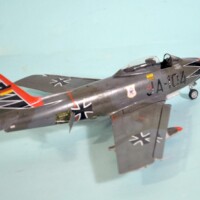
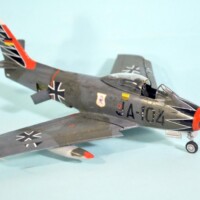
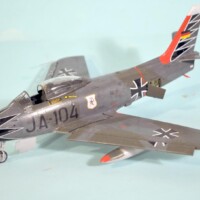
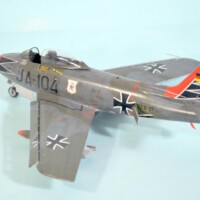

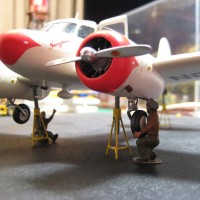

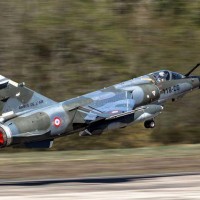
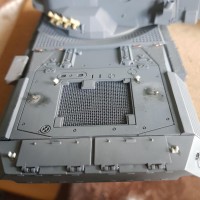
Excellent model - Tom. Dare I say it it's a very cute looking aircraft.
Yet another excellent model seen posted here, Tom! A beauty.
Wow, this looks very beautiful. I would love to see a bit more of the colors!
Makes me think about going back to my Airfix F86, which for some reason does not inspire me. Unfortunately.
The colors are both dark. Overexposure would be the only way to show them with any great differentiation.
@tcinla, Very nice work, and an interesting article Tom! 👍
Very well done. I have always loved this paint scheme honoring Hartman following his release from Soviet captivity.
Very nicely done, both, buiding and re-shooting the pictures, Tom @tcinla
A great supporting as well.
Those Sabres do look very nice, a pity I was not there yet to see them operational.
Great work! Unusual paiting!
That is a good-looking Sabre!
Another great build Tom. I've heard it said the Mk 6 would have done well over the skies of Vietnam.
As well as the RAAF Sabre 32 would have and the MiG-17 did.
Good looking Saber Tom @tcinla. Nice to know Red Roo picked up the slatted resin wing. I’ve ordered from them before. Good people.
Well done, Tom